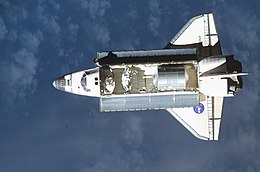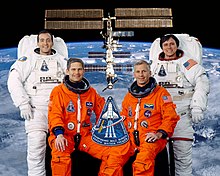STS-111

Endeavour approaches the ISS
|
|
| Mission type | ISS logistics Crew rotation |
|---|---|
| Operator | NASA |
| COSPAR ID | 2002-028A |
| SATCAT no. | 27440 |
| Mission duration | 13 days, 20 hours, 35 minutes, 56 seconds |
| Distance travelled | 9,300,000 kilometres (5,800,000 mi) |
| Spacecraft properties | |
| Spacecraft | Space Shuttle Endeavour |
| Launch mass | 116,523 kilograms (256,889 lb) |
| Landing mass | 99,385 kilograms (219,106 lb) |
| Payload mass | 12,058 kilograms (26,583 lb) |
| Crew | |
| Crew size | 7 |
| Members |
Kenneth D. Cockrell Paul S. Lockhart Philippe Perrin Franklin Chang-Diaz |
| Launching |
Valery G. Korzun Peggy A. Whitson Sergei Y. Treshchov |
| Landing |
Yuri I. Onufrienko Carl E. Walz Daniel W. Bursch |
| Start of mission | |
| Launch date | 5 June 2002 21:22:49 UTC |
| Launch site | Kennedy LC-39A |
| End of mission | |
| Landing date | 19 June 2002 17:58:45 UTC |
| Landing site | Edwards Runway 22 |
| Orbital parameters | |
| Reference system | Geocentric |
| Regime | Low Earth |
| Perigee | 349 kilometres (217 mi) |
| Apogee | 387 kilometres (240 mi) |
| Inclination | 51.6 degrees |
| Period | 91.9 minutes |
| Docking with ISS | |
| Docking port |
PMA-2 (Destiny forward) |
| Docking date | 7 June 2002 16:25 UTC |
| Undocking date | 15 June 2002 14:32 UTC |
| Time docked | 7 days, 22 hours, 7 minutes |
 (L-R): Philippe Perrin, Paul S. Lockhart, Kenneth D. Cockrell, Franklin R. Chang-Diaz |
|
STS-111 was a space shuttle mission to the International Space Station (ISS) flown by Space Shuttle Endeavour. STS-111 resupplied the station and replaced the Expedition 4 crew with the Expedition 5 crew. It was launched on 5 June 2002, from Kennedy Space Center, Florida.
STS-111, in addition to providing supplies, rotated the crews aboard the International Space Station, exchanging the three Expedition 4 members (1 Russian, 2 American) for the three Expedition 5 members (2 Russian, 1 American).
The Multi-Purpose Logistics Module (MPLM) carried experiment racks and three stowage and resupply racks to the station. The mission also installed a component of the Canadarm2 called the Mobile Base System (MBS) to the Mobile Transporter (MT) (which was installed during STS-110); This was the second componenet of the Canadian Mobile Servicing System, or MSS. This gave the mechanical arm the capability to "inchworm" from the U.S. Lab fixture to the MBS and travel along the Truss to work sites.
STS-111 was the last flight of a CNES astronaut, the French agency having disbanded its astronaut group and transferred them to the ESA.
Launch video (3 mins 11 secs)
Landing video (2 mins 29 secs)
...
Wikipedia

